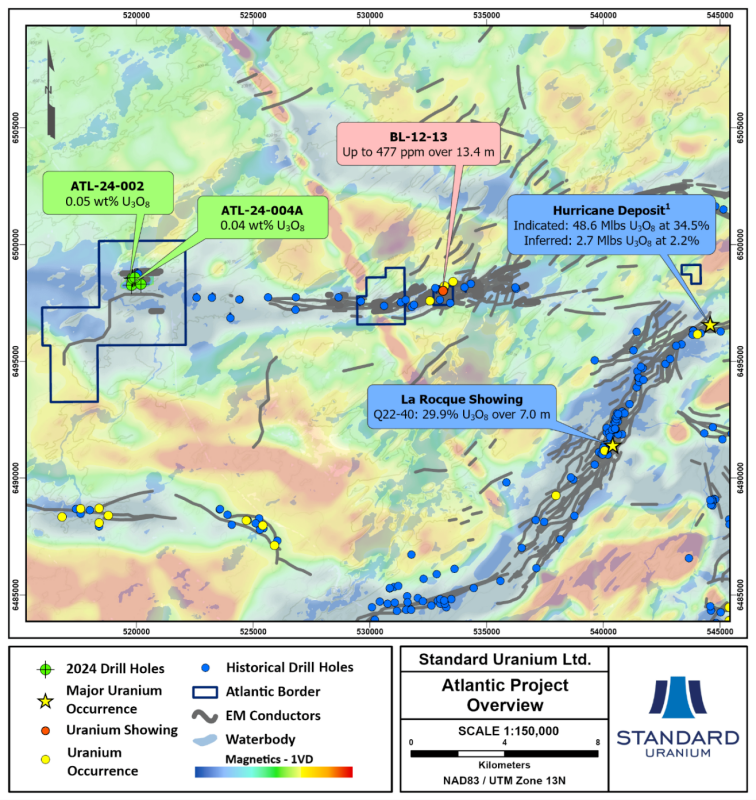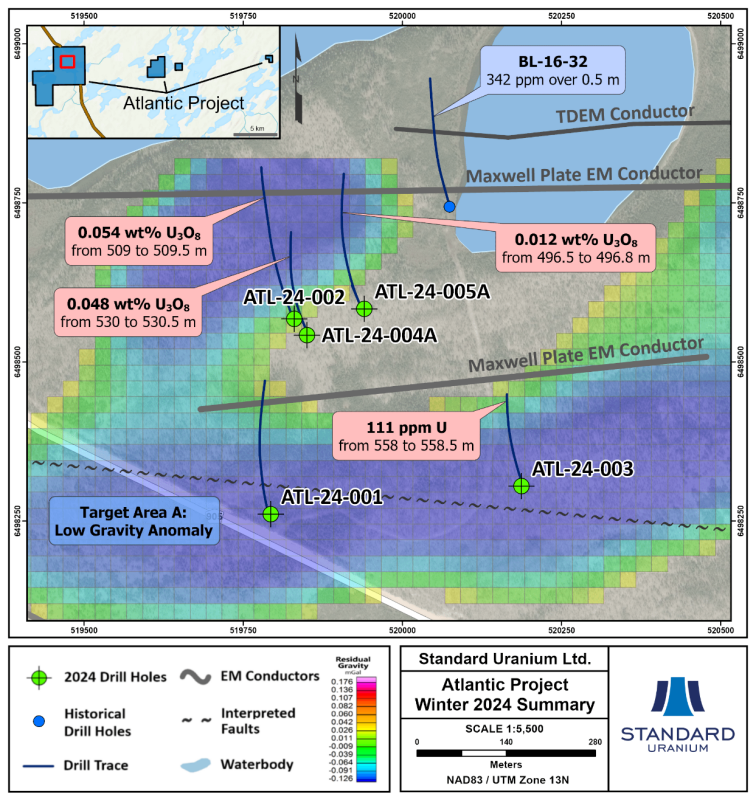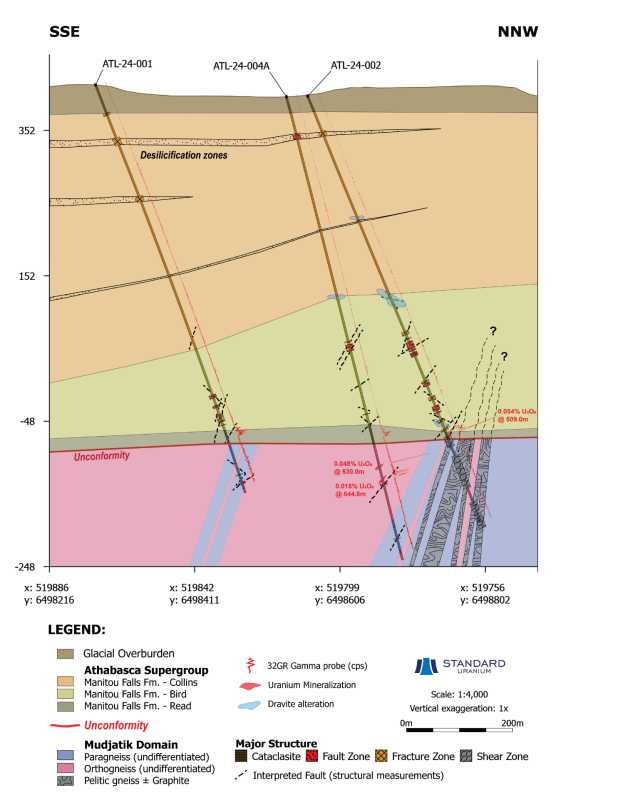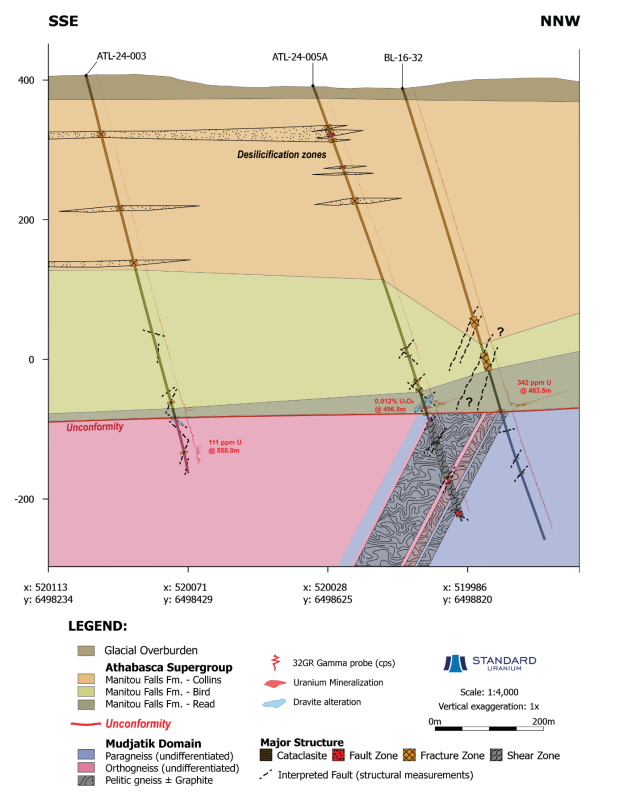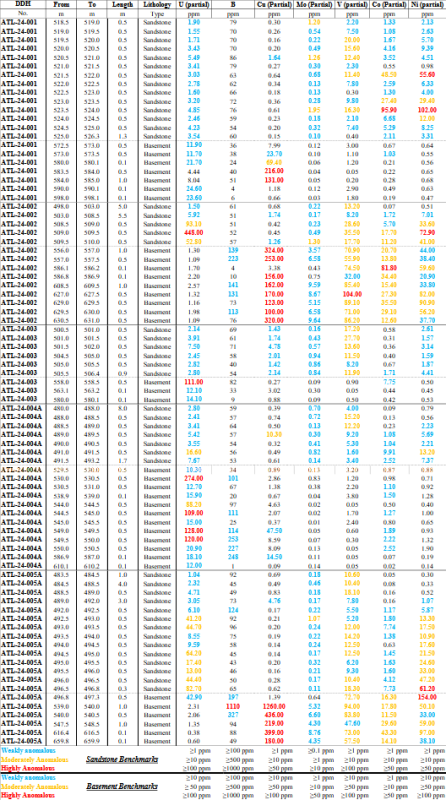Vancouver, British Columbia – TheNewswire - June 18th, 2024 – Atco Mining Inc. (the “Company” or “Atco”) (CSE: ATCM); (OTC: ATMGF); (Frankfurt: QP9) is pleased to provide a summary of analytical results from the inaugural winter 2024 drill program at its 3,061-hectare Atlantic Project (“Atlantic” or “the Project”) highlighting uranium mineralization in multiple drill holes. Atlantic is situated in the prolific eastern Athabasca Basin, northern Saskatchewan (Figure 1).
The Project is currently under option (the “Option”) with Standard Uranium Ltd. (the “Optionor”) an arms-length company listed on the TSX Venture Exchange (TSXV: STND). Pursuant to the Option, Atco can earn a 75% interest in Atlantic over three years. The winter 2024 drill program contributes to satisfying the first year of minimum exploration expenditures required by the Option.
Highlights:
-
Uranium Mineralization Confirmed: Analytical results from the winter 2024 drill program at the Project confirmed highly anomalous uranium in drill holes ATL-24-002, ATL-24-004A, and ATL-24-005A, coinciding with prospective structural zones and favorable alteration including dravite-rich clays
-
Sandstone Basement-Hosted Uranium: Multiple zones of elevated uranium linked to the sub-Athabasca unconformity and basement structural zones were intersected, indicating a uranium-fertile system.
-
Uranium Pathfinders: Several key uranium pathfinder elements are present in anomalous quantities in multiple drill holes, providing vectoring information for future programs. Intersections of dravitic-clay associated with structural zones has been confirmed in drill holes ATL-24-002, ATL-24-004A, and ATL-24-005A.
-
Verified Targets: Massive structural disruption confirmed in the sandstone column and multiple wide (10 metres) brittle-reactivated graphitic shear zones confirm the main interpreted electromagnetic (“EM”) corridor on the western claim block which was not reached by previous operators. The inaugural program results have confirmed the Company’s exploration thesis on the Project, highlighting a uranium-fertile system with several kilometres of still untested strike length across the Project.
-
Follow Up Targets Next Steps: Atlantic holds significant upside for discovery along the untested portions of the E-W conductor system. Supplementary geophysical surveys over the central claim blocks are currently being planned and will provide further target areas for phase II and III drilling, along with the additional untested gravity low anomalies on the western block identified in 2022.
“The intensity and scale of the dravite alteration in combination with the confirmed elevated uranium has me very encouraged with this modestly size initial drilling on Atlantic” says Neil McCallum, a director of Atco.
“I am extremely excited with the drill results of this first phase” says Etienne Moshevich, CEO of Atco. “I think we’re going to have a new re-rating on uranium as a whole and projects like the Atlantic Project should catch the attention of some much larger players. With these results in hand, our team is working to plan our next phase of exploration imminently.”
The Atlantic Project covers 6.5 km of an 18 km long, east-west trending conductive exploration trend which hosts numerous uranium occurrences. The Company completed a high-resolution ground gravity survey on the western claim block in 2022, revealing multiple subsurface density anomalies, potentially representing significant hydrothermal alteration zones in the sandstone rooted to basement conductors.
The Atlantic project boasts all the key characteristics to host a high-grade unconformity-related uranium deposit, and the results of the inaugural drill program on the project have strengthened the validity of the exploration thesis on the Project. Follow up targets are being planned as geological data from the winter 2024 program continues to be processed and interpreted. Core samples from the program have been submitted to Saskatchewan Research Council Geoanalytical Laboratory (“SRC”) in Saskatoon, for geochemical assay and results will be reported once received and examined by the technical team in accordance with the Company’s internal quality control processes.
Figure 1. Regional summary map of the Atlantic Project highlighting uranium occurrences, historical and 2024 drill holes, geophysical anomalies, and EM conductors.
Winter 2024 Drill Program Analytical Highlights:
The winter 2024 drill program comprised 3,316 metres of diamond drilling across 5 drill holes (Table 1). Inaugural drilling intersected the key characteristics of a uranium-bearing mineralized system in previously untested “Target Area A” (Figure 2), confirming the presence of a significant graphitic fault system in the basement rock linked to uranium mineralization and prospective hydrothermal alteration at the unconformity and in the basement rock. Uranium analytical highlights are summarized in Table 2 and anomalous uranium pathfinder elements highlights are summarized in Table 3.
The highly prospective drilling results are visually summarized in schematic cross-sections highlighting dravite alteration, structure, and uranium results intersected during the inaugural drill program in Figures 3 and 4.
The drill program was designed to follow up on highly anomalous uranium results returned from drill hole BL-16-32, in addition to testing the newly outlined gravity lows defined by the 2022 ground survey. On the western Atlantic claim block, drilling by Denison Mines in 2016 (Hole BL-16-32) identified 342 ppm uranium over 0.5 metres at the base of the sandstone, just north of Target Area A. Winter drilling was focused in Target Area A which is defined by a 1,400-metre x 850-metre density-low anomaly coinciding with stacked EM conductors and an interpreted regional fault. Figure 2 highlights winter 2024 drilling focused on testing the 3D density anomaly target at the unconformity linked to basement EM conductors and interpreted fault trends.
Figure 2. Map of the western Atlantic claim block, highlighting winter 2024 drill holes and historical drill hole BL-16-32. The geophysical “Target Area A” is defined by a significant residual gravity-low anomaly coinciding with EM conductors dipping to the south.
Table 1. Atlantic winter 2024 drill hole collar summary. Easting and Northing coordinates are reported in UTM Zone 13N, NAD83 datum; EOH = end of hole; m.a.s.l. = metres above sea level.
| DDH | Easting | Northing | Elevation (m.a.s.l.) | Azimuth (°) | Dip (°) | EOH (m) |
| ATL-24-001 | 519790 | 6498261 | 412 | 344.80 | -69 | 599 |
| ATL-24-002 | 519828 | 6498570 | 394 | 336.90 | -67 | 641 |
| ATL-24-003 | 520190 | 6498305 | 396 | 338.20 | -74 | 588 |
| ATL-24-004* | 519851 | 6498546 | 388 | 336.20 | -74 | 60 |
| ATL-24-004A | 519851 | 6498546 | 388 | 336.20 | -74 | 657 |
| ATL-24-005* | 519936 | 6498584 | 398 | 335.90 | -69 | 111 |
| ATL-24-005A | 519936 | 6498584 | 398 | 336.40 | -69 | 660 |
* Restarted due to difficult ground conditions.
Table 2. Atlantic winter 2024 drill hole uranium assay summary. Uranium parts-per-million (“ppm”) results are reported in partial digestion, with corresponding U3O8 weight percent (“wt%”) results where applicable.
| DDH | From (m) | To (m) | Width (m) | Lithology | Uranium (partial, ppm) | U3O8 (wt%) |
| ATL-24-001 | 590.0 | 590.1 | 0.1 | Basement | 24.6 | - |
| ATL-24-002 | 508.5 | 509.0 | 0.5 | Sandstone | 93.1 | 0.015 |
| 509.0 | 509.5 | 0.5 | 448 | 0.054 | ||
| 509.5 | 510.0 | 0.5 | 52.8 | 0.008 | ||
| ATL-24-003 | 558.0 | 558.5 | 0.5 | Basement | 111 | - |
| ATL-24-004A | 491.0 | 491.5 | 0.5 | Sandstone | 16.6 | - |
| 530.0 | 530.5 | 0.5 | Basement | 274 | 0.048 | |
| 544.0 | 544.5 | 0.5 | 88.2 | 0.014 | ||
| 544.5 | 545.0 | 0.5 | 109 | 0.015 | ||
| 549.0 | 549.5 | 0.5 | 128 | - | ||
| 549.5 | 550.0 | 0.5 | 120 | 0.018 | ||
| ATL-24-005A | 492.5 | 493.0 | 0.5 | Sandstone | 41.2 | 0.008 |
| 493.0 | 493.5 | 0.5 | 44.7 | 0.007 | ||
| 494.5 | 495.0 | 0.5 | 64.2 | 0.01 | ||
| 495.0 | 495.5 | 0.5 | 17.4 | 0.002 | ||
| 495.5 | 496.0 | 0.5 | 13 | 0.002 | ||
| 496.0 | 496.5 | 0.5 | 44.4 | 0.006 | ||
| 496.5 | 496.8 | 0.3 | 82.7 | 0.012 |
Figure 3. Schematic cross-section of drill holes ATL-24-001, ATL-24-002, and ATL-24-004A, facing west. Drill hole intersections of uranium, dravite alteration, and structure are highlighted.
Figure 4. Schematic cross-section of drill holes ATL-24-003, ATL-24-005A, and historical drill hole BL-16-32 (Denison Mines), facing west. Drill hole intersections of uranium, dravite alteration, and structure are highlighted.
Table 3. Atlantic winter 2024 drill hole pathfinder geochemistry summary. Results are reported in parts-per-million (“ppm”) partial digestion.
Samples collected for analysis were sent to SRC Geoanalytical Laboratories in Saskatoon, Saskatchewan for preparation, processing, and ICP-MS multi-element analysis using total and partial digestion, gold by fire assay, and boron by fusion. Sandstone samples were tested using the ICP-MS1 uranium multi-element exploration package plus boron. Basement samples were tested with ICP-MS2 uranium multi-element exploration package plus boron. All sandstone samples, and basement samples marked as radioactive upon arrival to the lab were also analyzed using the U3O8 assay (reported in wt %). Basement rock split interval samples range from 0.1 to 0.5 m and sandstone composite samples are comprised of multiple equal sized full core “pucks” spaced over the sample interval. SRC is an ISO/IEC 17025/2005 and Standards Council of Canada certified analytical laboratory. Blanks, standard reference materials, and repeats were inserted into the sample stream at regular intervals in accordance with Standard Uranium’s quality assurance/quality control (QA/QC) protocols. All samples passed internal QA/QC protocols and the results presented in this release are deemed complete, reliable, and repeatable.
Samples containing clay alteration were sent to Rekasa Rocks Inc. in Saskatoon, Saskatchewan to be analyzed by Short Wavelength Infrared Reflectance (“SWIR”) via a Portable Infrared Mineral Analyzer (“PIMA”) to verify clay species.
1 The Company considers radioactivity readings greater than 300 counts per second (cps) to be “anomalous”.
2 The Company considers uranium mineralization with concentrations greater than 1.0 wt% U3O8 to be “high-grade”.
3 Natural gamma radiation in diamond drill core reported in this news release was measured in counts per second (cps) using a handheld RS-125 super-spectrometer and verified using a down-hole Mount Sopris 32GR slim gamma probe. The 32GR gamma probe has been calibrated to optimize the probe for uranium exploration logging and estimating weight percent U3O8 content. Readers are cautioned that scintillometer and gamma probe readings are not uniformly or directly related to uranium grades of the rock sample measured and should be treated only as a preliminary indication of the presence of radioactive minerals. All drill hole intersections are measured down-hole. Core interval measurements and true thicknesses are yet to be determined.
The scientific and technical information contained in this news release, including the sampling, analytical and test data underlying the technical information contained in this news release, has been reviewed, verified and approved by Mr. Neil McCallum, PGeo, director of both Atco Mining and Standard Uranium and a qualified person as defined in National Instrument 43-101.
About Atco Mining (CSE: ATCM):
Atco is a junior exploration mining company focused on exploring for green energy metals throughout Canada. Atco is also exploring salt opportunities in Western Newfoundland. Investors are encouraged to visit the company’s website here: www.atcomining.com
For further information contact:
Atco Mining Inc.
Email:
Telephone: (604) 681-0084
Neither the Canadian Securities Exchange nor its Regulation Services Provider (as that term is defined in the policies of the Canadian Securities Exchange) accepts responsibility for the adequacy or accuracy of this news release. The Canadian Securities Exchange has not in any way approved nor disapproved the contents of this news release.
FORWARD LOOKING STATEMENTS:
Certain information in this news release may contain forward-looking statements that involve substantial known and unknown risks and uncertainties. Forward-looking statements are often identified by terms such as “will”, “may”, “should”, “anticipate”, “expects” and similar expressions. All statements other than statements of historical fact included in this news release are forward-looking statements that involve risks and uncertainties. There can be no assurance that such statements will prove to be accurate and actual results and future events could differ materially from those anticipated in such statements. Important factors that could cause actual results to differ materially from the Company’s expectations are detailed from time to time in the filings made by the Company with securities regulations. The reader is cautioned that assumptions used in the preparation of any forward-looking information may prove to be incorrect. Events or circumstances may cause actual results to differ materially from those predicted, as a result of numerous known and unknown risks, uncertainties, and other factors, many of which are beyond the control of the Company. The reader is cautioned not to place undue reliance on any forward-looking information. Such information, although considered reasonable by management at the time of preparation, may prove to be incorrect and actual results may differ materially from those anticipated. Forward-looking statements contained in this news release are expressly qualified by this cautionary statement. The forward-looking statements contained in this news release are made as of the date of this news release and the Company disclaims any intention or obligation to update or revise such information, except as required by applicable law.
Copyright (c) 2024 TheNewswire - All rights reserved.


